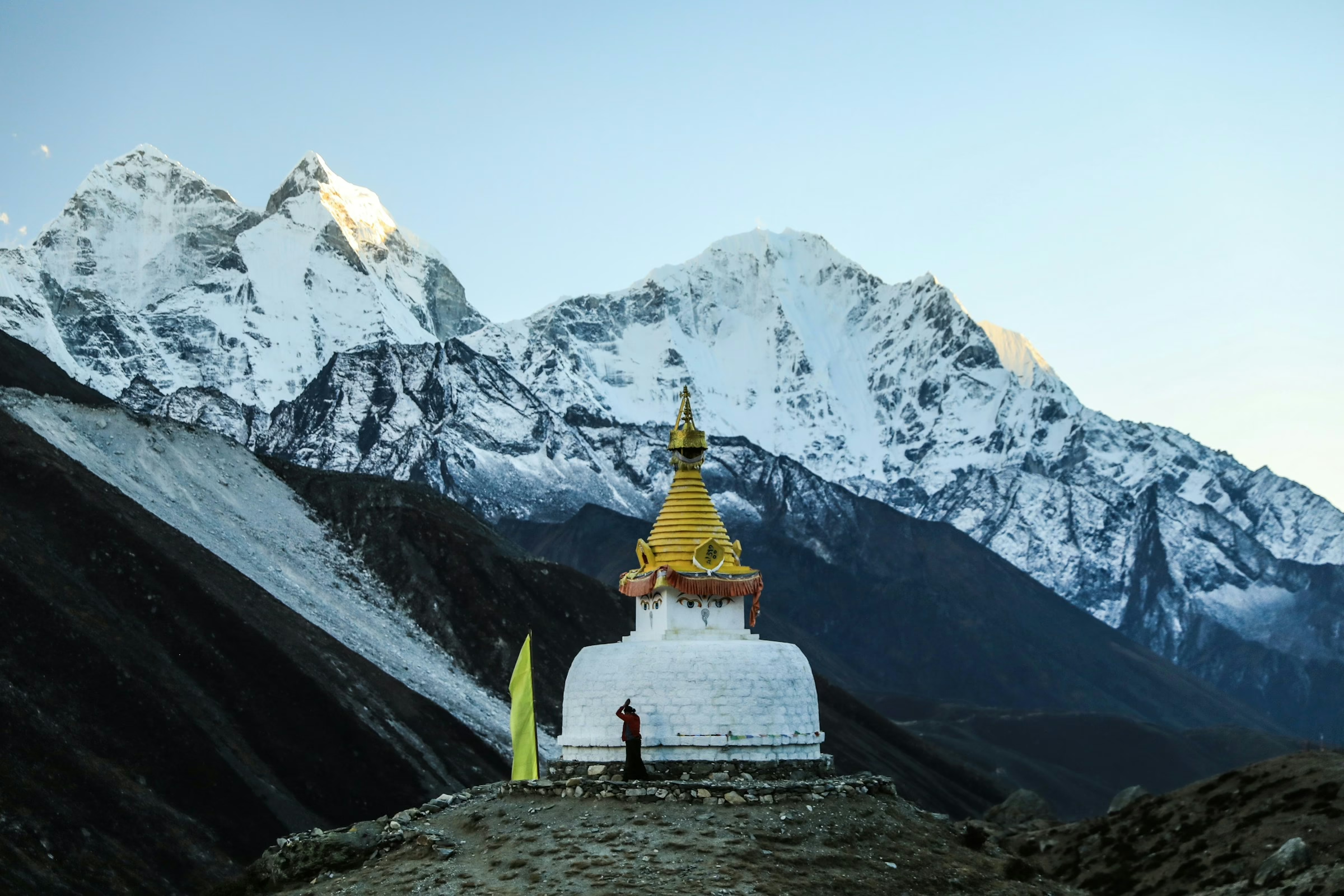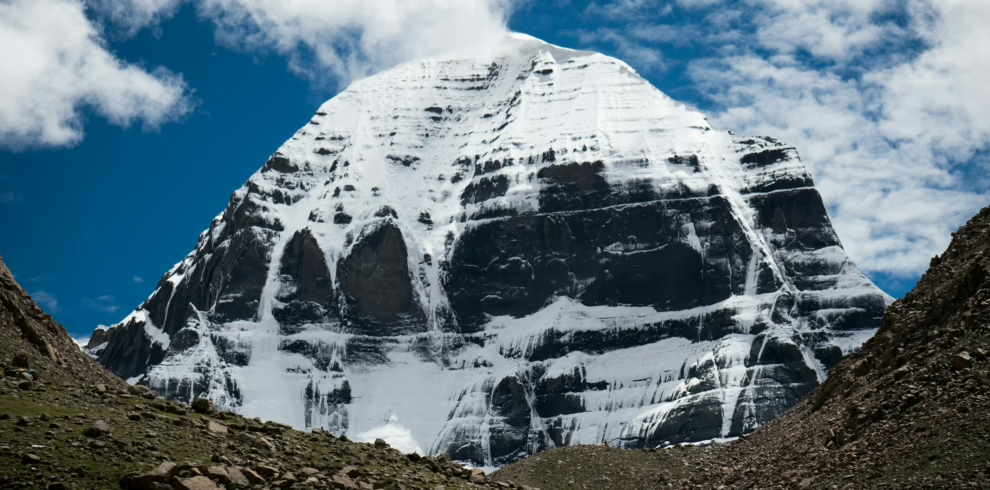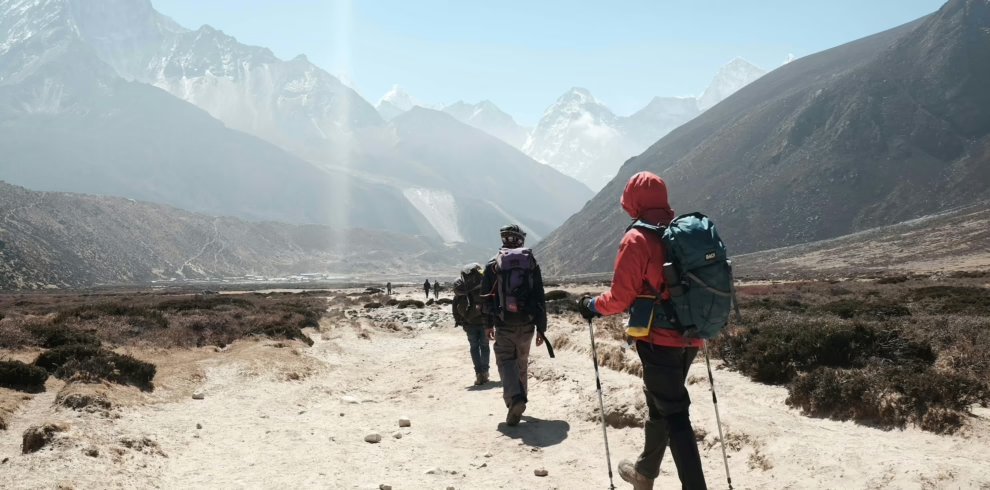For those seeking to immerse themselves in Nepal’s rich spiritual heritage, a monastery trek offers the perfect opportunity. The experience becomes even more captivating when combined with a journey to the upper Himalayas. If you’re short on time but still eager to explore Nepal’s spiritual heart, the Everest Monastery Yoga Trek is your ideal choice.
This trek is perfect for those who enjoy hiking at moderate elevations but are keen to reach higher altitudes to visit serene monasteries and gompas while taking in the breathtaking views of Mount Everest.
Imagine the perfect combination of yoga and hiking—two practices that complement each other beautifully. During the Everest Yoga Trek, you’ll have ample chances to admire stunning mountain vistas while participating in daily yoga sessions. Along with awe-inspiring landscapes, you’ll gain deep insights into Sherpa culture and traditions.
While the trek is challenging, the rewards are immense. The Everest Monastery Yoga Trek leads you to the heart of the Khumbu region, a world-renowned destination. Not only will you witness the grandeur of the world’s highest peaks, but you’ll also experience the spiritual awakening and deep cultural connection that make this area so unique. This journey is a perfect blend of natural beauty, cultural richness, and spiritual serenity.
10 days / 9 nights Everest Yoga trip
Discover Peace Above the Clouds at Everest Region
Highlights
- Stunning Trekking Trails: Explore the scenic routes of Nepal’s iconic Everest region, filled with natural beauty at every turn.
- Majestic Mountain Views: Experience breathtaking views of Mount Everest and surrounding Himalayan giants, creating an unforgettable backdrop for your journey.
- Yoga in Nature: Enjoy daily yoga sessions in peaceful, awe-inspiring locations, surrounded by the serenity of the mountains.
- Spiritual Immersion: Visit ancient Buddhist monasteries and engage in moments of reflection and meditation, deepening your spiritual journey.
- Sherpa Culture: Connect with the warm-hearted Sherpa community, immersing yourself in their rich traditions and way of life.
- Diverse Landscapes: Trek through lush forests, rugged terrain, and pristine glacial valleys, each offering unique scenery and challenges.
- Remote Villages: Discover the charm of traditional Sherpa villages, where life has remained largely unchanged for centuries.
- Adventurous Trails: Conquer exciting, challenging trails that lead to some of the most breathtaking vistas in the world.
- Nature’s Wonders: Encounter crystal-clear rivers, cascading waterfalls, and alpine meadows, all showcasing the natural splendor of the region.
- Wildlife Encounters: Keep an eye out for rare Himalayan wildlife, including exotic birds and elusive mountain species.
- Tranquil Escape: Disconnect from the fast pace of modern life and find peace in the tranquil beauty of the Himalayas, offering a rare opportunity for true reflection and relaxation.
Itinerary
Upon your arrival at Tribhuvan International Airport, our representative will greet you and transfer you to your hotel in a private tourist vehicle. Once you're settled at the hotel, we will schedule a trip briefing at the hotel lobby or restaurant.
After your morning yoga and asana session, begin the first leg of the Everest Yoga Trek with a drive from Kathmandu to Dhap Bazaar. The route follows the Sunkoshi River to Ghurmi Village, offering views of Nepal’s diverse rural landscapes—lush forests, terraced rice fields, and fast-flowing rivers. Upon arrival in Dhap Bazaar, you can enjoy a relaxed walk through the local markets.
After your morning yoga and meditation session, begin the trek from Dhap Bazaar to Jhapre. On the way to Sigane, enjoy views of the Numbur Himal range. From Sigane, you'll follow a partially constructed road for the first few hours. Jhapre (2,920 m), the first village you’ll reach, sits above a deep valley and offers stunning views of Everest and Numbur Himal. The village also features a stupa and a charming Buddhist monastery. You’ll spend the night in Jhapre.
After your morning yoga session at the Jhapre Monastery, begin the trek toward Pikey Peak. The trail climbs to a grassy ridge at Bhulbhule, offering stunning views of the Everest range. Just before Bhulbhule, the trail splits—take the right path toward Pikey Peak. Along the way, you'll pass old yak houses and a large mani stone wall. The route then follows a scenic forested trail along the Taklung Danda ridge, lined with rhododendron trees that bloom in spring. From the edge of the forest, it takes about two hours to reach Pikey Peak Base Camp.
An early morning start is essential to reach Pikey Peak in time for sunrise. The gentle ascent from Base Camp follows a trail along the mountain’s western slope. As dawn breaks, you'll be greeted by views of Thamserku (6,623m), with prayer flags fluttering near the summit of Pikey Peak just ahead.
From the top, enjoy panoramic views of Mt. Everest and six other 8,000-meter giants: Lhotse, Makalu, Annapurna, Manaslu, Kanchenjunga, and Dhaulagiri. After completing your yoga session, descend back to Base Camp through a serene pine forest. The air is crisp and clear, and you'll remain above 3,600 meters for most of the day. Continue your trek to Jasmane Bhanjyana, where you'll spend the night.
After your morning yoga and meditation session, you'll resume the Everest Monastery Yoga Trek. The trail leads through meadows and forested areas before reaching Taktor, where you'll stop for lunch. From there, you'll follow a wide gravel path toward Junbesi, with the option to visit a nearby Buddhist monastery along the way.
Junbesi features charming tea houses, a Buddhist stupa, and a vibrant mix of Sherpa, Magar, and Tamang communities. As you enter this scenic mountain village, you'll be welcomed by rivers, a lively monastery, and views of snow-capped peaks. With more accommodation options than previous days, Junbesi is an ideal place to rest and recharge.
While it's tempting to spend the day enjoying Junbesi's views, a short hike to Thuptenchholing Monastery is highly recommended. Perched above the valley, this is one of Nepal’s largest monasteries and is home primarily to female monks. It's a peaceful place to practice yoga, and visitors are welcome to explore the buildings and even peek into the kitchens. The monks are kind, welcoming, and gracious, making it a truly enriching experience.
Your early morning yoga and asana session will refresh you for the day ahead. As you descend along the quiet Everest Monastery Yoga Trekking Trail, you'll cross a steel suspension bridge over the Junbesi Khola, arriving at Beni Ghat. From there, the trail leads you through scenic landscapes toward Phaplu. In Phaplu, you can enjoy local food and drinks while experiencing a traditional Sherpa cultural performance.
After your morning yoga and asana session, you will fly from Phaplu to Kathmandu. Upon arrival, you'll be transferred to your hotel. The rest of the day is free for you to relax or explore. In the evening, Green Valley Nepal Treks will host a farewell dinner to celebrate the completion of your Everest Monastery Yoga Trek.
Based on your flight schedule, our staff will transfer you to the airport for your international departure.
Includes/Excludes
Cost Includes
- Airport pick-up from Kathmandu International Airport by private vehicle
- 2 nights in a standard hotel in Kathmandu
- All meals (breakfast, lunch, and dinner) with tea during the trek
- Accommodation in lodges or homestays during the trek
- Daily yoga sessions as per the itinerary
- English-speaking professional guide (includes food, salary, accommodation, equipment, insurance, and medical kit)
- All required permits and entry fees for the Pikey Peak Trek
- Bus ticket from Kathmandu to Dhap Bazaar (trek starting point)
- Flight ticket from Phaplu to Kathmandu (trek ending point)
- All government taxes and service charges
- Farewell dinner
Cost Excludes
- International airfare, Nepal visa, and travel insurance
- Lunch and dinner in Kathmandu
- Porter service (optional): USD 140 per porter, shared between two trekkers
- Extra nights in Kathmandu: US$35 per night (single room) | US$40 per night (double room) | US$50 per night (triple room), including breakfast
- Tips for guide and porter (expected at the end of the trek)
FAQs
The trek typically lasts 10 to 14 days, including both trekking and yoga sessions. The exact duration depends on the chosen itinerary and tour operator.
The trek is moderately challenging to strenuous, involving uphill and downhill trails over rugged terrain. Participants should be in reasonably good physical condition.
No prior experience is required. The trek is designed for varying fitness levels and yoga backgrounds. However, some physical preparation is recommended.
Spring (March–May) and autumn (September–November) are the best times, offering clear skies, stable weather, and comfortable temperatures. Winter is very cold, and the monsoon season (June–August) brings heavy rain and slippery trails.
Yes, due to the high elevations. To reduce the risk, follow a gradual ascent, take rest days, stay hydrated, and listen to your body.
Yes. You’ll stay in teahouses or lodges along the trail. These offer basic amenities such as beds, blankets, and shared dining areas. Facilities may be more limited in remote areas.
Yes, it’s recommended to bring your own yoga mat and any personal equipment for comfort and hygiene. Some operators may provide mats, but having your own is preferable.
Pack light but include essentials such as:
- Trekking gear (hiking boots, warm layers, rain jacket)
- Personal medications
- Quality backpack
- Reusable water bottle
- Sunscreen, hat, sunglasses
- Camera (optional)
The Everest Monastery Yoga Trek is the perfect journey for yoga enthusiasts looking to explore the breathtaking Everest region. This unique experience combines the tranquility of yoga with stunning mountain views, making it an unforgettable adventure. The trek takes you through the Khumbu region, surrounded by towering Himalayan peaks, which have long been a spiritual hub for pilgrims seeking enlightenment.
Along with scenic hikes, you’ll have opportunities to relax and rejuvenate through meditation sessions. The trek offers vibrant local culture, beautiful chortens, prayer stones, flags, and mesmerizing views of Kusum Kangru, the Dudh Koshi River, and, of course, the towering Mount Everest.
Throughout the trek, you’ll practice yoga in the mornings and immerse yourself in the natural beauty of nearby villages in the evenings. This is the perfect opportunity to learn yoga while surrounded by the majestic Himalayas.
At Green Lotus Trekking Pvt. Ltd, we offer a carefully crafted Everest Monastery Yoga Trek Itinerary for an experience of a lifetime. Book now for 2025 and 2026, and we are happy to adjust the package to fit your time, budget, and fitness level. Join us for this amazing adventure, and we’ll ensure every moment is memorable. For more information or details on pricing, feel free to contact us.
Benefits of Booking the Everest Monastery Yoga Trek with Us:
- International and Domestic Airport Pickup and Drop-off Service
- Free Everest Yoga Trek Map
- Oximeter to Monitor Blood Oxygen Levels
- Medical Kits for Emergency Use
- Free Excess Luggage Storage at Green Lotus Trekking Store During the Trek
What to Expect During the Everest Monastery Yoga Trek?
The Everest Monastery Yoga Trek offers a blend of cultural diversity, breathtaking landscapes, and spiritual adventure. You will explore the Khumbu Region, known for its majestic glaciers, towering mountains, and diverse wildlife. As you trek from Lukla to the Everest Himalayas, home to the world’s highest peaks, you will follow the historic routes of past legends.
Along the way, you will visit renowned Buddhist monasteries such as Thame, Tengboche, and Pangboche, as well as experience the ancient trails leading to Mount Everest. Each day begins with yoga practice, meditation, and pranayama, with many monasteries offering peaceful settings for reflection.
As you walk through the high Himalayas, you’ll immerse yourself in the tranquility of the region, stepping away from modern life to clear your mind.
Who is the Everest Monastery Yoga Trek Suitable For?
This trek is perfect for those interested in combining yoga with trekking in the stunning Himalayas. Here’s who will find it especially appealing:
- Yoga Enthusiasts: Ideal for those who want to deepen their practice in a serene, natural environment. You’ll practice yoga amid the beauty of the Himalayas, learning from experienced instructors.
- Nature Lovers: If you cherish the outdoors, this trek takes you through lush forests, sparkling rivers, and towering mountains, offering an unforgettable experience.
- Adventure Seekers: The combination of yoga and trekking offers a thrilling adventure. Tackle challenging trails, enjoy stunning views, and explore remote villages on this exciting journey.
- Spiritual Seekers: For those on a quest for spiritual growth, the trek offers visits to Buddhist temples, interactions with monks, and immersion in the spiritual customs of the Khumbu region.
- Cultural Explorers: Discover the unique Sherpa culture by visiting traditional villages, interacting with the locals, and learning about their customs and beliefs.
Preparation for the Everest Monastery Yoga Trek
The trek is suitable for those who can walk for 5 to 6 hours a day with a light backpack. Due to higher altitudes, physical exertion is greater, but most people in good physical condition can complete the trek with determination and a positive mindset. To prepare, focus on building strength, endurance, and cardiovascular fitness through regular exercise and jogging before your trip.
While prior hiking experience is helpful, technical skills are not required. Before embarking, consult with your doctor, especially if you have pre-existing health conditions such as heart, lung, or blood pressure issues. A medical check-up is required for participants with such conditions.
Useful Information for Everest Monastery Yoga Trek
Best Time for Everest Monastery Yoga Trek
The ideal times to undertake the Everest Monastery Yoga Trek are spring (March to May) and autumn (September to November).
- Spring: This season showcases vibrant wildflowers and rhododendrons along the route. The clear skies and moderate temperatures provide perfect conditions for trekking. You’ll have the chance to explore Sagarmatha National Park, the home of Mount Everest and a variety of wildlife.
- Autumn: With mild and comfortable weather, autumn offers excellent views of the Himalayan range. While the trails may be busier, it’s an ideal time to experience the trekking routes with pleasant conditions.
Food and Meals on Everest Monastery Yoga Trek
On the trek, enjoy both traditional Nepalese and international meals. Breakfast and dinner will be served at teahouses or lodges, while lunch is provided en route to the next destination. Common meals include omelets, fried rice, macaroni and cheese, Dal Bhat (rice, lentils, and vegetables), pizza, and vegetarian options. It’s recommended to avoid meat for hygiene reasons on the mountains.
Accommodation on Everest Monastery Yoga Trek
Accommodation consists of shared rooms with single beds, and extra blankets are usually provided, so sleeping bags are not necessary. Tea houses typically offer shared restroom facilities, with Wi-Fi and hot showers available for an extra fee. Charging is free at Everest guesthouses, and in Kathmandu, you will stay in a 3-star hotel with a private bathroom and free Wi-Fi.
Trek Difficulty
The Everest Monastery Yoga Trek is considered easy to moderate. While it does not require prior trekking experience, it’s important to be in good physical condition. The highest point reaches around 3,985 meters (in Pengboche), where altitude sickness can occur. Trekking during the monsoon (June to August) is more challenging due to slippery trails, so beginners should avoid this season.
Travel Insurance Requirements
Travel insurance is mandatory for all trekkers. It provides crucial coverage, including emergency helicopter rescues and medical evacuations. A comprehensive policy will also cover personal injury, illness, and repatriation costs, ensuring peace of mind during your journey.
Altitude Sickness and Remedies
To avoid altitude sickness, it’s important to ascend slowly. The trek is designed to allow for proper acclimatization, with a rest at Namche Bazaar. To prevent AMS (Acute Mountain Sickness), stay hydrated, eat well, avoid alcohol, and take Diamox if needed. If symptoms of altitude sickness appear, descend to a lower altitude immediately.
Packing List for Everest Monastery Yoga Trek
For the trek, you’ll need the following gear:
- Trekking Gear:
- Thermal clothing (top & bottom)
- Down jacket
- Waterproof jacket
- Fleece/wool trousers
- Hiking pants
- Warm gloves & hiking socks
- Trekking shoes with spare laces
- Sun hat, scarf, & sunglasses
- Sleeping bag (normal)
- Day bag (35L or more)
- Reusable water bottles (2L)
- Basic toiletries and personal first aid kit
- Yoga Gear:
- Lightweight yoga mat
- Comfortable, breathable yoga clothes
- Yoga blocks and straps (optional)
- Meditation cushion (optional)
Booking Procedure for Everest Monastery Yoga Trek
Green Lotus Trekking is a government-approved operator with over 10 years of experience. We are members of the Nepal Mountaineering Association (NMA) and the Trekking Agencies’ Association of Nepal (TAAN). To book, we require a 20% deposit of the total trip cost. Please email us essential documents (passport, photos, travel insurance, flight details) within a week of booking. Payments can be made via bank transfer, Western Union, or online. In Nepal, payments can be made by cash, bank transfer, or credit card. We will provide you with payment details and the total amount upon booking.





